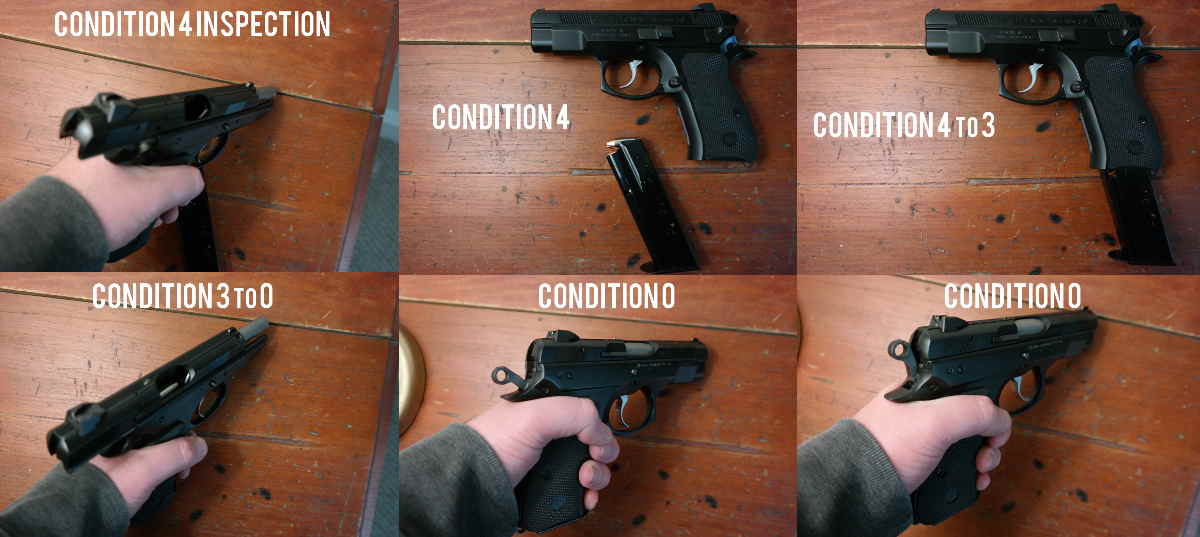Let’s clear the air before we get down and dirty on how ready a particular pistol is ready to fire. The condition system (“Condition 0, Condition 1, Condition 2, Condition 3, Condition 4”) is directly related to United States military manuals on their issued firearms. This condition system is meant to describe the number of steps to take a firearm from unloaded to ready to fire.
If we were talking about the M-16A2 semiautomatic rifle, there are five listed conditions according to the Marine Corps manual on this firearm despite only needing four steps to go from unloaded to ready to fire. For the M9 (MCRP 3-OIB, page 28), there are also five listed conditions while only four apply.
This makes it extremely difficult to “get it straight” when discussing firearm conditions.
The original “firearm conditions” were listed out by a guy named John Dean (“Jeff”) Cooper and they were specifically for the Colt M1911A1. His issued Colt M1911A1 that he used to develop modern handgun techniques had five basic firearm conditions.
- Condition 4:
- Chamber empty
- No magazine inserted
- Hammer down.
- Condition 3:
- Chamber empty
- A loaded magazine is locked into the magazine well
- Hammer is down.
- Condition 2:
- A round is in the chamber
- A loaded magazine is locked into the magazine well
- Hammer is down.
- Condition 1:
- A round is in the chamber
- A loaded magazine is locked into the magazine well
- Hammer is cocked to the rear.
- The safety is on.
- Condition 0:
- A round chambered,
- A loaded magazine is locked into the magazine well,
- Hammer is cocked to the rear
- Safety off.
If your firearm doesn’t have a safety or isn’t a single-action pistol, these conditions do not apply to your handgun.
The United States Marine Corps, at present, uses Condition 0 only when describing a firearm as being fully loaded, with a round in the chamber, and safety is off. For instance, Condition 1 for both the M16 and the M9 specifically refers to the safety being still engaged on both firearms.
We here in the civilian world, however, are under a lot of misconceptions and bad misinformation when it comes to describing a firearm’s condition. Through researching this subject, I discovered some fine nuances that even I had glossed over before. To boil it down, these conditions will be uniform for almost all semiautomatic pistols:
Condition 4:
- Chamber has been visually inspected to ensure it is empty.
- No magazine is inserted into the magazine well.
Condition 3:
- Chamber is empty.
- A loaded magazine is inserted into the magazine well.
Every step between 3 to 0 depends on TWO major factors:
- Firing mechanism (SA +1 Condition Step)
- Single action pistols must have their hammers cocked to the rear in order to fire.
- Double action and striker fire pistols do not.
- Presence of a manual safety (+1 Condition Step)
- A safety will remain engaged until just prior to firing.
- This is a step that is necessary to take or the pistol will not fire.
If you have a single-action Colt M1911 with a manual safety, you need five basic steps to go from unloaded to ready to fire.
So, for instance, a striker fire semiautomatic Glock handgun only has three basic firearm conditions: 4, 3, and 0.

Similarly, a single-action/double-action (SA/DA) CZ-75 PCR with no manual safety only has three basic firearm conditions: 4, 3, and 0.

NOTE: The presence of the hammer being cocked or not cocked is a moot point because it’s equally capable of firing a round.
The Beretta 92 FS is an example of a single-action/double-action semiautomatic pistol that can come with a manual safety.
Visually, the difference would be that once the magazine is loaded and a round is placed into the chamber, it is now in Condition 1. Manually disengaging the safety would bring that Beretta 92 FS from Condition 1 to Condition 0.
The idea that a SA/DA semiautomatic pistol can be placed into Condition 2 like the Colt M1911 is a relic stemming back from hand-me-down information. There is no Condition 2 for a SA/DA semiautomatic pistol because it can physically fire a round with the hammer down. The Colt M1911A1 could not. The hammer had to be drawn to the rear (“cocked”) in order for a trigger pull to send a bullet down range.
Similarly, for Double Action Only (DAO) semiautomatic pistols, there is no Condition 2. Condition 2 does not apply. If your DAO pistol doesn’t have a safety, Condition 1 does not apply.
In conclusion, it’s better to know the state of your pistol than to be too preoccupied about what condition it’s in.
- UNLOADED: There are no rounds in the chamber and no magazine is inserted. (Visually inspected)
- LOADED: Magazine is inserted.
- READY TO FIRE: Round in the chamber, magazine inserted, safety off. For single-action pistols, hammer is cocked.
We treat every gun as if it is loaded, so we always assume that a firearm is in Condition 0 until we can visually and manually inspect it. Upon receiving a firearm, we eject the magazine and lock the upper receiver to the rear so we can inspect the chamber for the presence of bullets. Only when we visually inspect and see no rounds in the chamber and no magazine inserted can we conclude a firearm is Condition 4.

